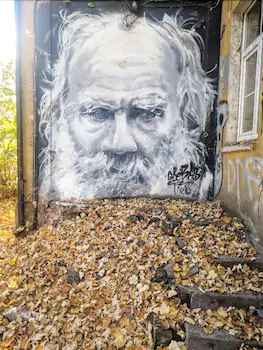Leo Tolstoy Archive
Written: 1862
Source: From RevoltLib.com
Transcription/Markup: Andy Carloff
Online Source: RevoltLib.com; 2021

Writing was conducted in the following method: — The pupils were taught simultaneously to recognize and form the letters, to spell and write words, to understand what was written, and to write. They would take their places round the wall, marking off divisions with chalk, and one of them would dictate whatever came into his head, and the others would copy it. If there were many of them, then they divided into several groups. Then they took turns in dictating, and all read it over to one another. They printed out the letters, and at first corrected the errors of spelling and syllabification, then those of misused letters.
This class formed itself. Every pupil who learns to write the letters is seized with a passion for writing, and at first the doors, the outside walls of the school and of the cottages where the pupils live, would be covered with letters and words. But they took .ven greater pleasure in writing a whole phrase, such, for instance, as this: "To-day Marfutka and Olgushka [22] had a fight."
In order to organize this class the teacher had only to teach the children how to act together, just as an adult teaches children to play any infantile game. And, in fact, this class went on without change for two years, and every time with as much gaiety and animation as in a good game. This included reading and conversation, and writing and grammar.
In this writing, the most difficult part of learning a language for a beginner is attained spontaneously: that is, faith in the unalterability of the form of a word whether printed or spoken their own word. I think that every teacher who tries to teach a language without depending on a grammar must meet with this first difficulty.
You wish to direct the pupil's attention to some word, menyd, "me," for example. You take his sentence: "Mikishka pushed me from the steps." That is what he said.
"Pushed whom?" you ask, wishing him to repeat the sentence, and hoping to hit on the word me.
"Nas us," he replies.
"No, but what did you say?" you ask.
"We fell off the steps, owing to Mikishka," or "Because he pushed us, Praskutka 2 flew down, and I after her," he will reply.
And here you try to get your accusative case and its ending. But the pupil cannot understand that there was any difference in the words he used.
But if you take a little book, or begin to repeat his sentence, he will distinguish with you, not the vital word, but something entirely different.
When he dictates, every word is caught on the fly by the other pupils, and written down.
"What do you say? what is that?" and they will not let him change a single letter.
In doing this disputes are all the time rising, from the fact that one writes one way and another another, and very soon the one who dictates begins to ponder how to say it, and begins to realize that there are two things in speech: form and content. He will utter some phrase, thinking only of its meaning. Swiftly, like one word, the phrase flies from his lips. The others begin to question him: "How?" "What?" and when he repeats it several times in succession he explains the form and the constituent parts of speech, and confirms them by a word.
Thus they write in the third, that is, the lowest, class one being able to use the cursive script, another printing his words.
We not only do not insist on the cursive script, but if we permitted ourselves to put any restrictions on the scholars, we should forbid them to write in the cursive script, which destroys the hand and is not legible.
Cursive letters spontaneously enter into their handwriting: a pupil learns a letter or two of one of the older boys; others imitate it, and frequently write whole words in this way: dyadenka, "little uncle," and before a week is over all are using the cursive script.